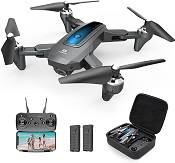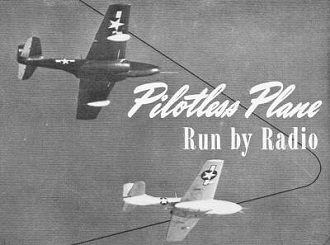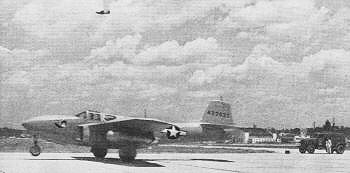|
May 1946 Radio News
 [Table
of Contents] [Table
of Contents]
Wax nostalgic about and learn from the history of early
electronics. See articles from
Radio & Television News, published 1919-1959. All copyrights hereby
acknowledged.
|
 News reports are full of features about
the wave of radio controlled (R/C) "drones" terrorizing citizens with their often
inexperienced pilots navigating their camera-laden craft to peer into bedroom windows,
obtain "birds-eye" views of sporting events, and to be a general pain in the posterior
to people trying to enjoy their right to privacy and safety (except, of course,
unless it is the Government choosing to violate them). Incredible advances in radio,
navigation, and sensor systems has facilitated a wide variety of very affordable
multirotor (the correct term, not "drone") aircraft that can literally fly themselves.
For under $500 you can buy a GPS-guided multirotor that can be programmed to fly
to one or more waypoints and return to the launch location, with range and flight
duration limited only by battery capacity. Gimbaled, remotely steerable cameras
can snap photos or record video and either store it onboard for later retrieval
or wirelessly transmit the images back to the operator. Platform stabilization is
provided by ultra-miniature, ultra-lightweight orientation and rate gyros with precision
and accuracy that could not have been realized even two decades ago. Intelligent
software practically negates the need for an operator to do anything other than
point the craft where he/she wants it to go. Compare this to what was considered
ground-breaking remotely piloted aircraft technology in 1946. News reports are full of features about
the wave of radio controlled (R/C) "drones" terrorizing citizens with their often
inexperienced pilots navigating their camera-laden craft to peer into bedroom windows,
obtain "birds-eye" views of sporting events, and to be a general pain in the posterior
to people trying to enjoy their right to privacy and safety (except, of course,
unless it is the Government choosing to violate them). Incredible advances in radio,
navigation, and sensor systems has facilitated a wide variety of very affordable
multirotor (the correct term, not "drone") aircraft that can literally fly themselves.
For under $500 you can buy a GPS-guided multirotor that can be programmed to fly
to one or more waypoints and return to the launch location, with range and flight
duration limited only by battery capacity. Gimbaled, remotely steerable cameras
can snap photos or record video and either store it onboard for later retrieval
or wirelessly transmit the images back to the operator. Platform stabilization is
provided by ultra-miniature, ultra-lightweight orientation and rate gyros with precision
and accuracy that could not have been realized even two decades ago. Intelligent
software practically negates the need for an operator to do anything other than
point the craft where he/she wants it to go. Compare this to what was considered
ground-breaking remotely piloted aircraft technology in 1946.
Pilotless Plane Run by Radio

Planes in the radio remote control of aircraft project, developed by the Air
Technical Service Command and Bell Aircraft Corporation. Both are jet-propelled
P-59 Airacomets with the controlling flight station, the "mother" ship, shown at
the top.
By S. R. Winters
The successful operation of aircraft by remote radio control has been proven
practical by the A.T.S.C.
Transforming a 20-year-old vision into an actuality, a pilotless airplane is
operated by a combination of factors involving the use of radio and television.
The jet-propelled plane, a P-59 Airacomet, is remotely controlled either from a
portable ground radio station, mounted on a truck, or from a "flying radio station"
in another airplane which "mothers" the robot craft.
"Telemetering," a comparatively new term as applied to radio, and only recently
recognized officially by the Federal Communications Commission, means that electronic
apparatus installed on the pilotless flying craft transmits to the ground radio
station visual images of the vibrations, accelerations, structural leads and strains,
and similar stresses encountered by the robot plane. This new telemetering apparatus,
designed by Princeton University, is concentrated in the pilotless plane and ground
radio station, the "mother" plane being reserved for the exclusive function of controlling
the "orphan" craft which flies without any person aboard. The process of determining
structural strains and stresses, as well as other data from the pilotless plane,
involves the use of resistance units in measuring the plane's performance electronically.
Such information is fed, in sequence, to the electronic transmitter at a rate of
1100 cycles per second. This data is transmitted to the ground radio station for
reception by a radio receiver that unscrambles the jargon of combined signals and
then "siphons" them into separate. receiver channels for graphic recording or visual
observation, or both, on a many-channeled oscillograph.
The television equipment on the pilotless plane, manufactured by the Radio Corporation
of America, serves a twofold purpose. One unit visualizes the instrument panel on
the robot airplane, thus televising the behavior of the instruments during the plane's
flight, and this information is relayed to the operator of the ground radio station.
The second piece of television apparatus, installed in the cabin of the plane without
a human pilot, actually scans the horizon as it would be seen if an honest-to-goodness
pilot were flying the machine and this vision of the horizon as viewed by the "robot"
is relayed to the operator of radio equipment in the motor truck.

Three physical components of the radio remotely controlled plane project developed
by the Air Technical Service Command and Bell Aircraft Corporation. Left to right.
the panel truck which operates the controlled, or robot plane and incorporating
telemetering and television equipment for observation and recording of flight research
data; the robot plane and the controlling plane. Both aircraft are P-59s.
This experimental aircraft, joint brain-child of the Bell Aircraft Corporation
and the Air Technical Service Command, Wright Field, Dayton, Ohio, is a preview
of an imminent period of flight of commercial airplanes through the combined factors
of radio and television. More than a year ago this writer forecast the imminence
of the "all electronic airplane" - a craft functioning solely by "electronic fingers"
rather than by the hands of a human pilot. Although the Bell Aircraft Corporation
is using this experimental jet-propelled plane as a sort of "flying research laboratory"
in assembling data that might influence the flight behavior of a plane, the company
believes that remote control of aircraft by radio is impending, both from a commercial
and military viewpoint. Furthermore, by use of this robot plane the risks of sacrificing
human pilots in hazardous flights at sonic and supersonic speeds are averted.
The successful flights of this radio-operated plane - since October, 1944, but
until recently among the war-pigeoned secrets - are attributed largely to a new
concept of the auto-pilot - described as the "rate" auto-pilot by Robert M. Stanley,
chief engineer of the Bell Aircraft Corporation. This novel gadget, automatic in
performance, assures control of a plane where the orthodox autopilot leaves off
- and it can function dependably when the craft is approaching a diving altitude.
Turbo jet-powered planes were chosen for the initial tests with pilotless, radio-operated
flying machines for several "down-to-earth" reasons, namely, the absence of torque
and vibration; their stability even at the speed of sound; their efficiency in the
stratosphere or other high altitudes; and the stability they demonstrate when landing
by means of tricycle landing gear.
More about the new version of the autopilot - the "rate" autopilot - which receives
the lion's share of credit in realizing the aeronautical engineer's dream of controlling
aircraft solely through the means of radio and television. Instead of the standard
autopilot, controlled by a gyroscope which spins about its vertical axis and is
therefore subject to "spilling" in violent maneuvers, the new type of autopilot
makes use of two rate-of-turn gyro instruments. One of these is so arranged that
the gyroscope's spin-axis is vertical as a means of affording a way of sensing a
change of pitch. The second gyro device is rotated so as to place the gyroscope
fore and aft, thus providing a method for determining the rate of roll.

Radio controlled jet plane lands at Wright Field by remote control. Either the
"mother" plane shown in flight, or the truck ground station at right can control
the plane.
Then, these two sensing gadgets - the "rate" and "displacement" auto-pilots-are
coupled in an electrical bridge, with their functions being interchangeable. The
"displacement" or orthodox autopilot is answerable for maneuvers involving less
than plus-or-minus 30 degrees change in pitch or plus-or-minus 45 degrees in roll.
The new version of autopilot - the "rate" mechanical pilot with its spill-proof
gyroscope, is answerable for any other maneuvers to which an airplane may be subjected.
The "flying radio laboratory," as well as the ground radio station, has a switch,
handy on the instrument panel, which permits of easy selection of the two autopilots.
Simultaneously, either or both of these mechanical pilots can be governed from both
air and ground radio stations,
A diminutive "joy" stick, functioning like the conventional control stick on
a standard airplane, is mounted on the usual stick in the "mother" plane and another
pigmy stick, a duplicate, appears on the ground radio operator's chair. This small
stick is secured to a platform built on top of the radio-equipped motor truck. The
movements of these midget sticks are comparable to those of the conventional "joy"
stick. Moved forward, for example, the miniature stick prompts the impulse that
lowers the airplane's elevators, causing the radio-controlled plane to dive; moved
backward, the undersized stick prompts a climb, and to the right or left, a turn
of the airplane in either direction.
The throttle, flaps, landing gear, brakes, etc., of the radio-operated plane
are actuated by the usual servo motors, deriving their electrical energy from circuits
controlled by the radio receiver. Thus, by coordinating these controls, the radio
operators of the flight or ground stations can put the robot through such actions
as warm-up, taxiing, take-off, climb, level flight, banks or turns, dives and loops.
The operation of this radio or electronic airplane is dependent upon novel and
heretofore untried apparatus, with special and secret radio parts, designed especially
for Army Air Forces' Technical Service Command, This radio equipment is as vital
to the functioning of the airplane television and telemetering equipment as are
the heart and lungs in the functioning of the human body. The incorporation of high-frequency
radio apparatus for voice communication is optional rather than a requirement, we
are told.
Posted May 11, 2022
(updated from original post on 3/5/2015)
|